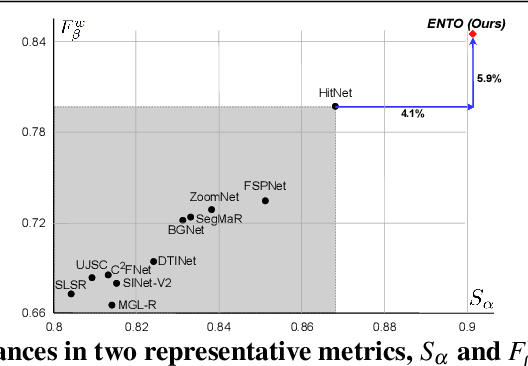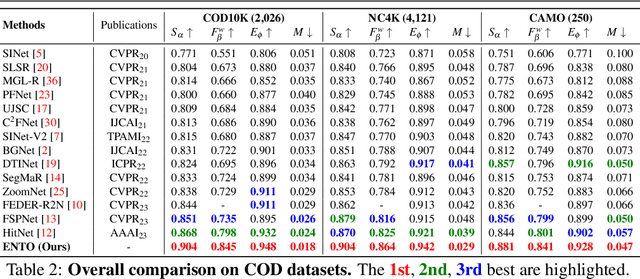Suyoung Kim
A Revisit to the Decoder for Camouflaged Object Detection
Mar 18, 2025



Abstract:Camouflaged object detection (COD) aims to generate a fine-grained segmentation map of camouflaged objects hidden in their background. Due to the hidden nature of camouflaged objects, it is essential for the decoder to be tailored to effectively extract proper features of camouflaged objects and extra-carefully generate their complex boundaries. In this paper, we propose a novel architecture that augments the prevalent decoding strategy in COD with Enrich Decoder and Retouch Decoder, which help to generate a fine-grained segmentation map. Specifically, the Enrich Decoder amplifies the channels of features that are important for COD using channel-wise attention. Retouch Decoder further refines the segmentation maps by spatially attending to important pixels, such as the boundary regions. With extensive experiments, we demonstrate that ENTO shows superior performance using various encoders, with the two novel components playing their unique roles that are mutually complementary.
* Published in BMVC 2024, 13 pages, 7 figures (Appendix: 5 pages, 2 figures)
Contrastive and Consistency Learning for Neural Noisy-Channel Model in Spoken Language Understanding
May 23, 2024



Abstract:Recently, deep end-to-end learning has been studied for intent classification in Spoken Language Understanding (SLU). However, end-to-end models require a large amount of speech data with intent labels, and highly optimized models are generally sensitive to the inconsistency between the training and evaluation conditions. Therefore, a natural language understanding approach based on Automatic Speech Recognition (ASR) remains attractive because it can utilize a pre-trained general language model and adapt to the mismatch of the speech input environment. Using this module-based approach, we improve a noisy-channel model to handle transcription inconsistencies caused by ASR errors. We propose a two-stage method, Contrastive and Consistency Learning (CCL), that correlates error patterns between clean and noisy ASR transcripts and emphasizes the consistency of the latent features of the two transcripts. Experiments on four benchmark datasets show that CCL outperforms existing methods and improves the ASR robustness in various noisy environments. Code is available at https://github.com/syoung7388/CCL.
Do not think pink elephant!
Apr 22, 2024Abstract:Large Models (LMs) have heightened expectations for the potential of general AI as they are akin to human intelligence. This paper shows that recent large models such as Stable Diffusion and DALL-E3 also share the vulnerability of human intelligence, namely the "white bear phenomenon". We investigate the causes of the white bear phenomenon by analyzing their representation space. Based on this analysis, we propose a simple prompt-based attack method, which generates figures prohibited by the LM provider's policy. To counter these attacks, we introduce prompt-based defense strategies inspired by cognitive therapy techniques, successfully mitigating attacks by up to 48.22\%.
Coreset Selection for Object Detection
Apr 14, 2024



Abstract:Coreset selection is a method for selecting a small, representative subset of an entire dataset. It has been primarily researched in image classification, assuming there is only one object per image. However, coreset selection for object detection is more challenging as an image can contain multiple objects. As a result, much research has yet to be done on this topic. Therefore, we introduce a new approach, Coreset Selection for Object Detection (CSOD). CSOD generates imagewise and classwise representative feature vectors for multiple objects of the same class within each image. Subsequently, we adopt submodular optimization for considering both representativeness and diversity and utilize the representative vectors in the submodular optimization process to select a subset. When we evaluated CSOD on the Pascal VOC dataset, CSOD outperformed random selection by +6.4%p in AP$_{50}$ when selecting 200 images.
 Add to Chrome
Add to Chrome Add to Firefox
Add to Firefox Add to Edge
Add to Edge